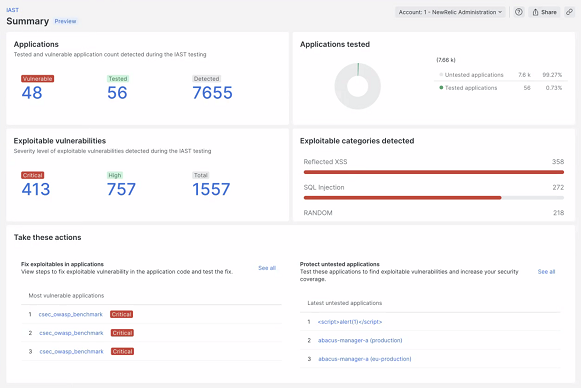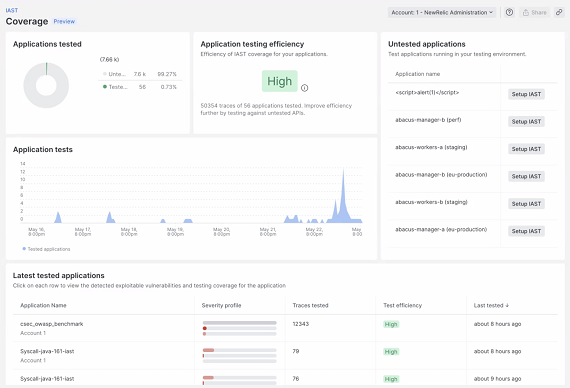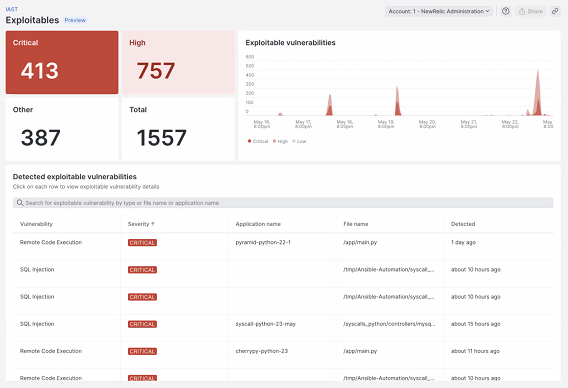
New Relic has announced the public preview of New Relic Interactive Application Security Testing (IAST).
“To help engineers future-proof applications and minimise security concerns, it’s imperative that they reimagine the way they build and secure cloud-native applications,” said New Relic Chief Product Officer Manav Khurana. “Adopting a converged observability and security approach is a must in order to help engineers deliver optimised user experiences. Developers have long used New Relic APM to identify and address performance issues not just in production, but before they deploy new versions of applications as well. Now, they can use the same New Relic APM agent to power actionable vulnerability insights and reduce security risks earlier before it impacts their organisation’s bottom line.”

“More secure applications help protect customer’s personal data, enhance privacy, and reduce disruptions. In turn, this leads organisations to realise key competitive advantages like increased customer trust and loyalty, reduced financial losses, greater regulatory compliance, improved operational efficiency, and better risk mitigation— ultimately contributing to the long-term success and sustainability of their business,” said IDC Group Vice President Stephen Elliot. “Applying security testing during the application development and testing stages can ensure issues are caught well before they impact customers, while helping modernise the SDLC by providing customers with a more secure and highly reliable experience.”
The growth in DevOps has enabled teams to build and ship software faster than ever before—yet 85% of applications still contain vulnerabilities.
With vulnerabilities and exposures expected to rise throughout this year to 1,900 per month, engineering and security teams must take a context-driven approach that accurately identifies, prioritises, and verifies vulnerabilities with proof-of-exploit for faster remediation.

And, current application security testing methods often rely on a reactive approach, which can result in increased costs, false positives, and missed release cycles.
“New Relic IAST represents the next evolution of New Relic’s security strategy, enabling developers to identify and work towards eliminating exploitable code early on in the DevOps cycle,” said New Relic Chief Architect APJ, Peter Marelas. “With New Relic IAST, developers don’t need to sift through false positives – our technology is specifically designed to eliminate them through patented deterministic techniques that identify and provide automated vulnerability validation with proof-of-exploit capabilities. This ensures engineers and security teams are able to focus on security risks that matter.”

Key features and benefits include:
- 360 visibility: View the application stack and associated relationships with context-driven insights to reduce blind spots and validate remediation efforts.
- Reduce false positives: Advanced detection accuracy, risk-based prioritisation, and automated vulnerability validation ensure teams focus on real security risks.
- Proof of exploit: Find, fix, and verify exploitable vulnerabilities with dynamic assessment capabilities that pinpoint the source of vulnerabilities by simulating real-world attacks.
- Accelerate remediation: Guided remediation, guardrails, and status tracking help developers avoid critical mistakes across the software development lifecycle (SDLC).
- Scale at will: Easy deployment via existing APM agent and seamless integration with CI/CD pipelines and ticketing systems prevent disruption of existing processes and workflows.
“Our team has historically relied on traditional, complex tools to identify security risks, causing us to spend a lot of time and resources to find and fix vulnerabilities before they could impact our business and our customers,” said Agustín Paroli, Head of IT Operations at D24. “New Relic IAST empowers our developers to code with confidence by automating work and providing a comprehensive view of security risks, including real-time feedback, accuracy, and context-aware security analysis—all in the context of our observability practice and without impeding the development process. This enables our team to prioritise security and observability, helping them identify risks earlier in the development lifecycle and deliver a better experience for our customers.”






